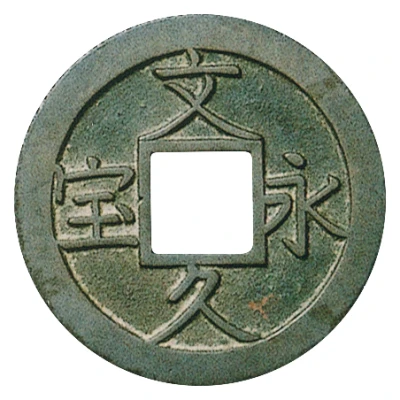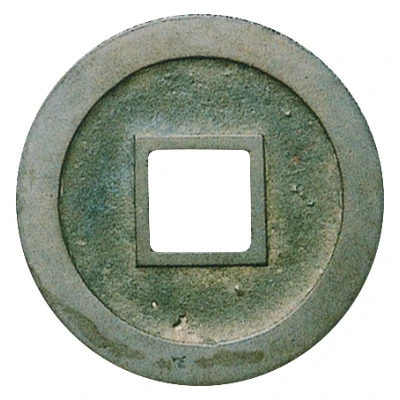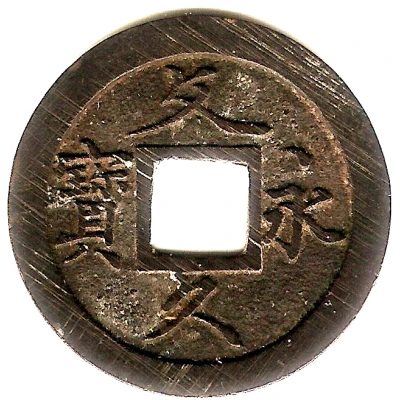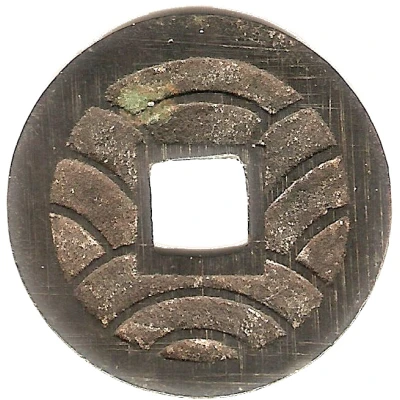
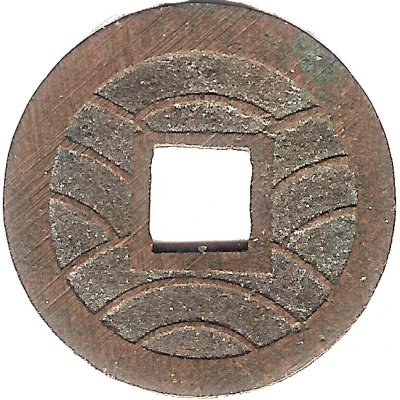

© Sak
4 Mon "Bunkyūeihō" Regular script; 文久永寶 ND
| Copper | - | 27 mm |
| Issuer | Japan |
|---|---|
| Type | Standard circulation coin |
| Years | 1863-1868 |
| Value | 4 Mon |
| Currency | Mon (683-1953) |
| Composition | Copper |
| Diameter | 27 mm |
| Shape | Round with a square hole |
| Technique | Cast |
| Orientation | Medal alignment ↑↑ |
| Demonetized | 31 December 1953 |
| Updated | 2024-10-05 |
| Numista | N#147018 |
|---|---|
| Rarity index | 32% |
Reverse
11 waves
Edge
Plain
Comment
In the 2nd month of the 3rd year of Bunkyū, a copper coin with the inscription Bunkyūeihō was put into circulation. These coins were mostly made out of the old one mon coins, thus their alloy does not contain zinc.The coin was intended to replace the unpopular iron Kan'eitsūhō 4 Mon, however, people used the coin by compared value to iron 1 Mon coin. In 1865, Bunkyūeihō was 8 Mon (while Brass Kan'eitsūhō 4 Mon worth 12 Mon), and in 1867 Bunkyūeihō was 15~16 Mon (while Brass Kan'eisūhō 4 Mon worth 20~24 Mon).
Bunkyu Eiho was the last of the traditional cast cash coins to be introduced. In 1868, the minting machinery that had been in use in Hong Kong was brought to Osaka, and by 1870 machine struck gold, silver, and copper yen and sen coins had started to be made. Bunkyūeihō had been used for, generally, 1.5 Rin (0.0015 Yen, as 1 Yen = 1 Ryō = 10000 Mon) until the law of demonetizing old currencies came into effect in 1954. However, in some area, such as Kōchi, Wakayama, Kōbe, it was accept for only 1 Rin.
Mintage shown below is overall mintage of all Bunkyūeihō coin.
________________
Bunkyūeihō Regular script has the most subvariants compared to and . However, Bosen of Regular script is much more rare than the other two and copper Bosen of Regular script generally more expensive than tin Bosen of Cursive or Simplified Hō.
① tall narrow 永; 永 higher than hole rim → KŌSEN see position of waves on reverse
①Ⓐ low waves; wave 6th and 8th have almost the same length; left leg 文 shorter than hole rim → KŌSEN HAITEIHA
①Ⓑ high waves; wave 6th longer 8th; large side triangle; left leg 文 almose same as hole rim → KŌSEN HAIKŌHA
② bottom of 永 lower or same as hole rim → see position of crown of 寶
②Ⓐ crown of 寶 as high as hole rim → CHOKUEI 10~23 more subvariants
②Ⓐ➊ CHOKUEI 5~10 more subvariants
②Ⓐ➋ SAIJI 4~9 more subvariants
②Ⓐ➌ head of 久 with hook → SENJI up to 4 subvariants
②Ⓐ➌ⓐ right leg of 寶 connect to body → SENJI
②Ⓐ➌ⓑ right leg of 寶 separate from body → SENJI RISOKUHŌ
②Ⓑ crown of 寶 much lower hole rim → FUKAJI 8~12 more subvariants
②Ⓑ➊ FUKAJI KYŌEI 4~5 more subvariants
②Ⓑ➋ FUKAJI KŌEI 2~5 more subvariants
②Ⓑ➌ FUKAJIDE 2 more subvariants
広穿背低波 KŌSEN HAITEIHA (left) and SENJI (right)
Interesting fact
The 4 Mon "Bunkyūeihō" coin was issued during the Bakumatsu period, a time of great change and modernization in Japan. The coin's design features a combination of traditional Japanese characters and Western-style numerals, reflecting the country's shift towards modernization and Westernization during this period.
Price
| Date | Mintage | VG | F | VF | XF | AU | UNC |
|---|---|---|---|---|---|---|---|
| ND (1863-1868) | - | - | - | - | - | - |
Values in the table are based on evaluations by sales realized on Internet platforms. They serve as an indication only for 4 Mon "Bunkyūeihō" (Regular script; 文久永寶) ND (1863-1868) coin.
